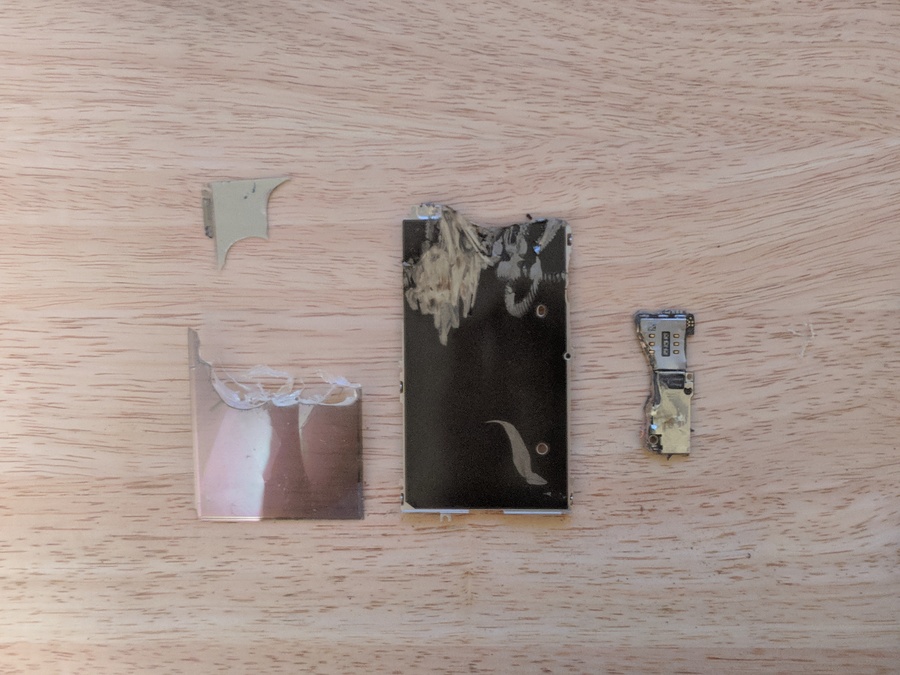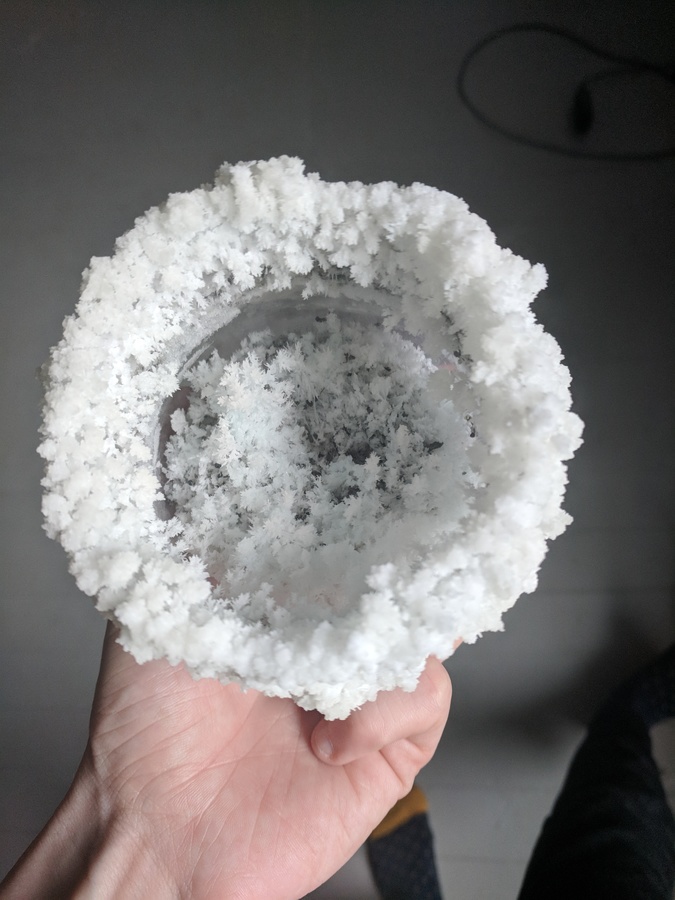Sand in the gears
Prelude
Ingrid Burrington writes, makes maps, and tells jokes about places, politics, and the feelings people have about both. She’s the author of Networks of New York: An Illustrated Field Guide to Urban Internet Infrastructure. Her work has been supported by Eyebeam, Data & Society, and the Center for Land Use Interpretation.
Conversation
Sand in the gears
For TCI x Are.na's Library of Practical and Conceptual Resources, Ingrid Burrington meditates on the geological construction of modern life, and what it means to live in a state of "aggregate."
I’m working on a new project that involves sanding and grinding down a piece of an iPhone until it’s a pile of dust. While I do this, I sometimes watch videos of iPhones being destroyed in various ways, a genre of YouTube video that seems to comprise a mix of DIY foundry enthusiasts, power-tool geeks, and people selling blenders. In these videos, iPhones get covered in molten liquid metal, boiled in Coca-Cola, or made subject to man’s most portentous question, Will it blend? (Reader, it blends.)
What I’m doing isn’t quite as instantaneously cathartic as what happens in the videos. There are faster–and safer, though probably not by much–ways to destroy an iPhone (for example, shredders at e-waste recycling centers, or industrial pulverizers). Aside from not having access to an industrial pulverizer, I’m trying to take my time with this task and meditate on the breakdown of metals and toxins that I’m hoping my ventilation mask and safety goggles will protect me from.
I’m slowly sanding this iPhone down into a pile of black and gray and glass fragments because I want to see if I can make it look more like the materials it’s actually made of.
For all the alchemy and labor that make iPhones appear untouched by human hands, at the end of the day all digital devices are just a bunch of slowly accumulated rocks, refined with chemicals and petroleum. Really, the entirety of today’s real-time information ecosystem sits on top of a dense sediment of ancient geology.
This may or may not be reassuring information. It can conjure scarcity anxiety: we could run out of these precious resources, and then how would our (fraught as it may be) way of life continue? But if the early 21st century’s love affair with tar sands oil teaches us anything, it’s that “running out” of a resource is the wrong question; the question humanity needs to worry about is what devastating environmental and political lengths it is willing to go to in order to not “run out” of a resource.
Computation is generally not perceived as something that could ever “run out.” One of computer history’s most persistent and prevailing myths is that computational power will eventually give way to limitless human ingenuity and development. This rhetorical infinitude is, in part, reinforced by a misunderstanding about its material infinitude. After all, much of hardware history centers around a material that’s generally thought of as a sort of ubiquitous and humble one: silicon, i.e. sand.
“Next to oxygen, [silicon is] the most common ingredient on earth,” notes William Shatner in the 1976 AT&T educational film Microworld. A shot of computer chips lifted by gentle winds along a sandy terrain drives the point home: The future of computing is limitless, as it’s powered by this infinite and inexhaustible resource.
But that’s not actually how it works. I can’t just head to the nearest beach, fill a bucket with sand, and generate a pure silicon crystal ingot at home. Most sand isn’t pure silica. Rather, it’s full of the detritus of its local geologic context (and, increasingly, a distributed geologic context as petroleum rendered into tiny pieces of plastic). The kind of silica used in computer chips is more often made from pulverized quartzite, and there are only so many manufacturing sites in the world that can make electronics-grade pure silicon metal.
Figuring out where that special sand comes from can be challenging. Histories of companies like Texas Instruments and Fairchild Semiconductor (who were at the forefront of developing silicon chips) tend to emphasize how they figured out how to work with pure silicon, instead of where they got the silica to begin with. If it came from the United States, it seems plausible that their source was Spruce Pine, North Carolina, which is known for its exceptionally pure quartzite.
So computers aren’t made out of mere generic sand. Really, there’s no such thing as “generic sand.” Sand is perceived as generic because most people only look really closely at sand if they’re geologists, or maybe if they’re really high. Technically though, we’re looking at sand all the time. There’s sand peeking out from all the cracks and contours of modern life. The glass of my phone’s touchscreen and my laptop monitor and the window I stare out while procrastinating on this essay–all were formed from sand. It’s in the concrete and drywall used to construct the building I’m sitting in right now. It’s in roads and bridges. It’s being blasted deep into the earth in hydrofracking wells and formed into the foundation of solar panels that provide an alternative to that hydrofracking. It’s dredged out of seabeds to build artificial islands.
We have built the world on foundations of sand–albeit varying and very specific kinds of sand.
Desert sand like what you’d find in the seemingly endless Sahara is too smooth and fine to be used in construction; grittier riverbed sand and certain desalinated sea sands are preferable for construction. This means that the kinds of sand that can be used for roads and concrete actually are in somewhat limited supply–though that limit has more to do, again, with the limits of what’s deemed appropriate and inappropriate resource extraction, and those limits can easily become porous.
The process of accumulating that “right kind of sand” has been a subject of environmental and political controversy throughout the world. While headlines about the world “running out of sand” admittedly read a little hyperbolic, the harms of “sand mafias” and people killed by sand mafias—as well as the environmental harms of dredging and mining sand—are entirely real.
Appropriately, the industrial term for the sand-gravel-quarried-rock mixture central to constructing the future is the same term used by the tech industry to describe data that’s been made monetizable (and/or weaponizable): aggregate. Computers aren’t exactly made of sand, but the economics and politics of sand writ large have a lot in common with the economics and politics of a digitally networked world. The appeal of platform capitalism, for instance, is related to the anachronistic vision of chips wrest from humble sand.
Just imagine: with the right set of processes (chemical, algorithmic, or otherwise) we can smooth out and purify the messy geology of data into a shiny, tidy, legible form, placing unstructured humanity in a crucible of technical buzzwords and coming back with an ingot of pure consumer information. The massive global scale of producing both kinds of aggregate can make following its supply chains dizzying. Big industry likes for data to be granular, but rarely sees value in the individual grains.
There’s actually something kind of unsettling and itchy about looking at individual data carefully, even my own. When I deleted my Facebook account, I didn’t bother downloading my data. Aside from the fact that the company almost certainly hasn’t actually erased it, I’m not sure I see much benefit in reliving every shitty ex-boyfriend and every poorly thought-out overshare. The notion of someone else assessing that data provokes a related but different discomfort, like those Spotify ads about individuals’ listening habits that made me painfully self-conscious about what kind of cliché a marketer would label my listening habits under.
But almost no one at a giant platform actually puts those little particular grains of me under a microscope. It’s not personal; it’s aggregate. Industry runs on and demands large quantities of digital and stone-based aggregate, and its appetite is seemingly insatiable. Toxic destruction (of seabeds, of riverbanks, of cities, of individual futures, of social dynamics, of political systems) is accepted as an inevitable cost of doing business—an externality rendered someone else’s problem.
At times, living in a networked world can feel like a different kind of specialized sand: quicksand.
As I work through this essay I have felt frequently overwhelmed by the sensation that I am sinking underneath the sheer weight of information. Every tab opened with a new thread of research inquiry, every fleeting check of Twitter, every email notification, every microaggression, every take, every meme cascades and after enough time it starts to feel like being buried alive.
Rather than simply suffocating in sand, I become of sand—a life dissolved into a series of stupid granular data points that never completely re-cohere as solid rock. Robert Smithson might have written about this state as emblematic of one of his favorite subjects, entropy–”a closed system which eventually deteriorates and starts to break apart and there’s no way you can really piece it back together again.”
So how does one stay grounded and mindful in this unsteady world built on sand? Most options are heavy with cliché. I could tell you to find a bit of solid rock and hold fast to it, or to hunker down and hide from the sandstorm. But at best, that’s only buying some time before you have to reckon with reality. I could tell you to make space for the careful sifting-through of things, and to pay attention to the minutiae of sand grains rather than resorting to consumer-driven alchemical processing, but that feels patronizing and assumes access to an amount of free time that nobody has to spare. I might as well tell you to buy a little Zen garden kit or read Goop or something.
The most honest answer, I think, is to not read mindfulness as a euphemism for optimism, as a return to a simpler way of being, or as a kind of rational productivity.
There is a mindfulness to letting one’s sanded, granular self become sand in the gears of platform capitalism; intentions to be set in embracing entropy as an opportunity to build something incredible and unexpected rather than a state of decay and dread.
Eventually this world built on sand will give way to another world built on sand, and another, and another. You may not live to see these other worlds, but your matter will shape them.
I am arguably at my most intentional and mindful these days when I’m wearing away at the edges of an old iPhone–not because I’m returning the device to its granular natural state or because the phone has lost its use-value as a phone, but because it requires me to make space for thinking through what words like natural, functional, and reasonable mean when describing technical interfaces and environmental conditions.
Trying to holistically take into account all of the stuff that goes into computing and building the future makes it apparent that the work of building a world requires gestures so much bigger than closing a browser tab.
It requires breaking apart and building something new and unfamiliar from those pieces rather than continuing to build the same structures again and again. To see the world as its grains of sand, and to remain attentive to the networks and systems of this era often means facing ugly truths. Building equity or justice into networked technologies is a perpetually Sisyphean project, but necessarily so.
For the Library of Practical and Conceptual Resources, Ingrid has compiled a channel of images and links related to this essay.
- Name
- Ingrid Burrington
- Vocation
- Visual artist, Writer

Some Things
Pagination









